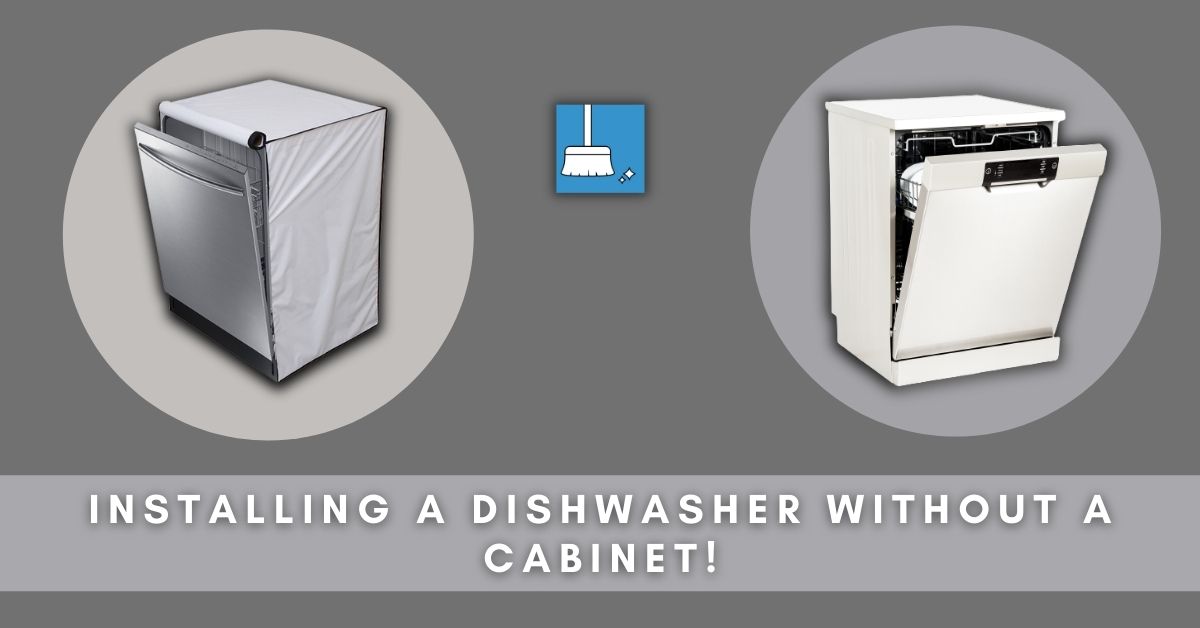You have just bought a dishwasher, but do not have a cabinet to place it inc. What are your options?
Read on to find out more about cabinets for dishwashers, the purpose of cabinets, and installing the appliance without the need for a cabinet.
Installing a Dishwasher Without a Cabinet!
Dishwashers are usually placed in cabinets for various reasons. However, some dishwashers do not need to be placed in a cabinet. You may move into a house with a smaller kitchen, so it is good to know whether to get a dishwasher that is installed in a cabinet or one that does not need a cabinet.
There are cabinets that you can build to your requirements, and also those that blend in with your kitchen aesthetics.
This article looks at dishwashers that do not need a cabinet, the different types of dishwashers, and cabinet requirements for certain dishwashers.
Do You Absolutely Need a Cabinet for a Dishwasher?
No, a dishwasher cabinet is not required. All that is required is an opening that can access the wiring and plumbing.
Dishwashers are useful appliances and are installed in the kitchen. Most users do not want them to be seen, so they are placed under kitchen counters and inside dishwasher cabinets.
The purpose of the cabinet is to securely hold the dishwasher in place and keep the connections out of sight.
Integrated dishwashers are slightly different, as they are specifically built into the space designed for them. These dishwashers match the other appliances and blend into the kitchen aesthetics.
Portable or countertop dishwashers come within their own specially designed housing unit.
If you feel you need to place the dishwasher in a cabinet, you can also build one to your specifications.
Different Dishwashers & their Placement
There are several types of dishwashers, as listed below:
| Built-in Dishwashers | These fit under the countertop near the kitchen sink. It is a permanent installation. |
| Portable Dishwashers | These can be moved around as they are freestanding. They provide extra countertop space as they don’t necessarily need a countertop to be placed upon. |
| Countertop | These are smaller than the portable dishwashers. |
| Drawer Dishwashers | These have drawers instead of a door. These are ideal for smaller households. |
| Integrated Dishwashers | These can be fully integrated and semi-integrated. These are built-in as well and once installed, are completely hidden, thus providing a seamless look to your kitchen. |
You can opt for one which suits your needs the best.
What Is the Difference Between a Portable Dishwasher and a Built-In Dishwasher?
Below are the differences between the 2 most popular ones – portable dishwashers and built-in dishwashers:
Portable Dishwashers
As the name suggests, portable dishwashers can be moved around, thus making them ideal if you have limited kitchen space.
a) Usually, all portable dishwashers have wheels making it easier to move the appliance around. When you need to use it, you roll it near the sink, use as required, and roll it back into the place you store it.
b) It can also be used as additional countertop space, either for preparing or chopping food.
c) These are cost-effective as they cost much less than the built-in dishwashers. There is also no need to change the cabinetry and these dishwashers are very simple to install, thus saving you money.
d) There is no need to buy a dishwasher if you move houses. You simply take the portable dishwasher with you.
e) It is a better option for a small family where there are smaller loads of dishes to wash. This proves to be more energy-efficient and cost-effective.
f) Portable dishwashers have fewer styles and models than built-in ones. The features are also fewer than the ones in a built-in dishwasher.
g) You must keep connecting and disconnecting it to your sink, which can lead to faster wear and tear of the plumbing.
h) Portable dishwashers can be quite noisy, as there is no cabinet to surround them and muffle the noise.
Built-in Dishwashers
These are built-in to your kitchen cabinets and have a permanent connection to the kitchen sink.
a) Compared to a portable dishwasher, these cannot be moved around. These are installed in the kitchen cabinets, making them almost invisible in your kitchen, thus giving a neater look.
b) Built-in dishwashers have more advanced and multiple features than portable ones.
c) They are connected directly to the water supply, so you can use the faucet while the appliance is still running a cycle.
d) Built-in dishwashers are surrounded by the cabinet, so the noise is muffled, making them quieter than the portable dishwashers.
e) Built-in dishwashers take up storage space in the kitchen. This space could have been used for other functions.
f) You may need to pay for the installation if needs to be done by a plumber. The appliance will also need to be correctly connected to the electric wiring of the house.
g) These are more expensive than the portable dishwashers, due to the larger size and increased functionality they offer.
You should shop around and decide what kind of dishwasher will serve your purpose.
How To Install Dishwashers Without Cabinets?
Depending on the types of dishwashers, the installation may vary slightly for each. Most under-counter dishwashers are 24″ in width and depth and 35″ in height.
Before installation, you must ensure there is enough space for the dishwasher to fit in, and that the electric and plumbing requirements are nearby.
Before installing any kind of dishwasher, you must switch off the power supply and disconnect the water supply and read the instruction manual.
Installation is similar for the different types of dishwashers. The difference is mainly in how to drain the water, depending on the kind of dishwasher used.
Installing a Dishwasher
First, we will look at how to install a dishwasher that will be near the kitchen sink permanently, as these are standard steps for most dishwasher installations, whether or not a cabinet is required.
STEP 1: Disconnect the power supply and turn off the water supply.
STEP 2: Place the dishwasher in the area you want to, and ensure it is near the kitchen sink.
STEP 3: Attach the water supply hose to the dishwasher using the dishwasher 90.
STEP 4: Connect the other end of the water supply hose to the hot water line under the sink. Use a dual-outlet shutoff valve so it can be used for both the faucet as well as the dishwasher.
STEP 5: Connect one end of the drain hose to the dishwasher and the other end to the drain or the garbage disposal, by using either a high loop or an air gap method.
a) An air gap is a safety device that prevents dirty water from being siphoned back into the dishwasher.
b) A high loop is where the drain hose is looped to a point above the dishwasher level to prevent dirty water from flowing back into the dishwasher.
STEP 6: Most dishwashers are hardwired, so they are directly connected to the electric system of the house.
How to connect the electric wires:
a) Connect the ground wire to the green ground screw
b) Connect the house wires to the dishwasher wiring using twist-on wire connectors. Connect black to black and white to white wires
c) Tuck the wires inside the terminal box and close it
STEP 7: Turn the water supply and electricity back on. You are ready to use the dishwasher.
Installing an Integrated Dishwasher
An integrated dishwasher blends in with the kitchen aesthetics and is customized to fit the kitchen, giving it a seamless look. It is less noisy than other ordinary dishwashers and slightly bigger. Integrated dishwashers also have a kitchen cabinet door panel attached to the front.
You will usually need a dishwasher installation kit with a new dishwasher. Most dishwashers already come with one.
STEP 1: Decide where to place the dishwasher.
STEP 2: The steps for connecting the hoses and electrical wiring remain the same as above. You may need to cut a hole in the side of the nearest cabinet to allow the fittings go through.
STEP 3: Adjust the height of the dishwasher so it is level with the countertops.
STEP 4: Attach the panel to the front of the dishwasher. This is usually bought separately, depending on the look of your kitchen.
Installing a Countertop Dishwasher
These are dishwashers small enough to be placed on a counter near the sink. The dishwasher will come with the items needed to connect it to the kitchen faucet. These dishwashers do not need to be placed in a cabinet.
STEP 1: Place the dishwasher on a counter and ensure it is level.
STEP 2: Connect the hoses as stated above.
STEP 3: Ensure the drainage hose flows downwards from the dishwasher, to prevent dirty water from flowing back into the dishwasher.
STEP 4: Plug the unit into the power supply as these are not hardwired dishwashers.
Freestanding Dishwasher Cabinets
Freestanding dishwashers already come with a special ‘housing unit’. The tops of these units can be customized with a wooden or laminate top, that can be used as extra countertop space. They can also be used as a kitchen island.
This will give you extra preparation space, especially if the kitchen has few countertops.
Custom-made Dishwasher Cabinets
If you do not have a dishwasher cabinet, then you can custom-make one. Note the following points:
a) The popular material for a dishwasher cabinet is usually wood. The thickness of the boards should be at least 3/4″.
b) Measure the width, height, and depth of the dishwasher. Add 1/2″ to the three dimensions and measure and cut the wood accordingly.
c) For the top, you can either have a laminate or a butcher block.
IKEA kitchen installations can also be used for the entire kitchen. These are kitchens designed by IKEA to be installed by the end-user. These kitchens include cabinets, countertops, drawers, and doors.
Do Freestanding Dishwashers Need to Be Plumbed In?
Freestanding dishwashers need to be plumbed in, though they are simple to install and do not have any complex plumbing requirements. Because they are portable, they are easy to disconnect from the plumbing.
Freestanding dishwashers connect to the kitchen sink faucet via a hose. The dirty water comes out through a separate hose directly into the drain of the sink.
Steps to install a freestanding dishwasher:
STEP 1: Place your dishwasher near the sink.
STEP 2: Connect the right hoses to the dishwasher first. Check the instruction manual to confirm which hose to connect to the correct place.
STEP 3: Attach the tap adapter to the faucet. This is to connect the hoses to the dishwasher. Ensure to use the correct size washers.
STEP 4: Freestanding dishwashers use a fitting called a coupler that is attached to the tap adapter. One hose supplies the dishwasher with clean water, and the other hose drains the dirty water from the dishwasher into the sink.
STEP 5: Plug in the dishwasher.
STEP 6: Open the faucet and run the cycle you want to use.
Conclusion!
The type of dishwasher you purchase depends on your needs, budget, and space. The installation process of various dishwashers is similar.
If you have your own house, it may be ideal to purchase a built-in dishwasher. If you are in a rental, a portable dishwasher is better for you, so you can take it when you move.
It is not necessary to place the dishwasher in a cabinet, as it is down to personal choice. If you currently do not have a cabinet, you can always get one made if your needs change. Always consult a plumber if you are unsure of the fixtures.






Pingback: Can You Install A Dishwasher Without A Countertop? (How?) »